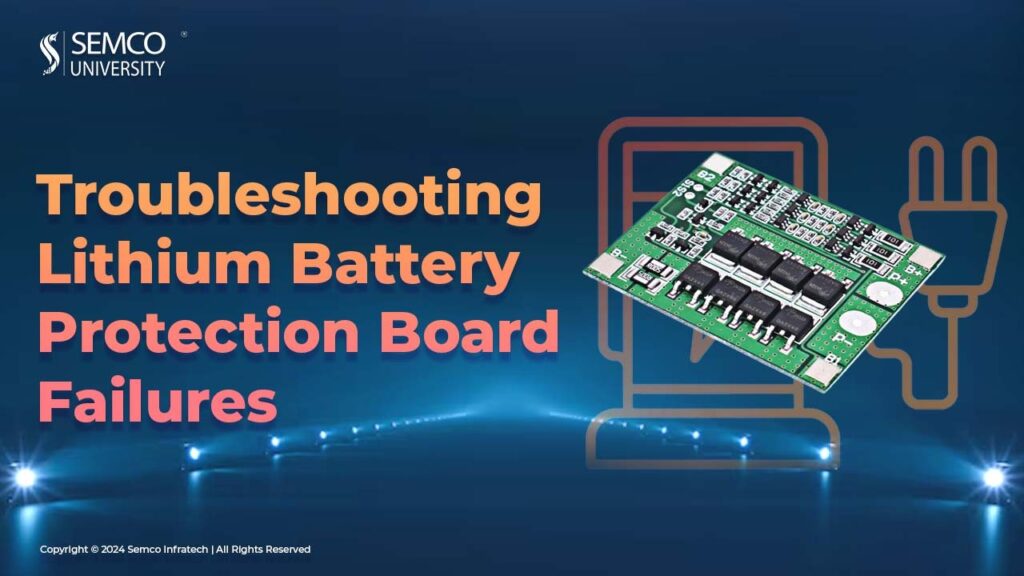Lithium battery technology has revolutionized the way we power portable devices and electric vehicles. However, the safe and efficient operation of lithium batteries relies on a crucial electronic component known as the Battery Protection Board.
This board monitors and controls critical parameters such as voltage, current, and temperature to ensure the battery’s safe operation. When the protection board fails, it can lead to various issues and potential safety risks. In this article, we will conduct a detailed analysis of common failure scenarios and provide solutions to address them.
I. Fault Analysis of Lithium Battery Protection Board:
Failure to Charge or Discharge:
(a) Component Damage: Components within the protection board, including protection chips, inductors, and capacitors, may deteriorate over time or become damaged due to external factors.
(b) Poor Welding Connection: Weak or improperly executed welding connections can lead to disruptions in the internal circuit, preventing the protection board from functioning correctly.
(c) Component Aging: After prolonged use, components within the protection board can experience wear and tear, leading to performance degradation.
Unbalanced Battery Charge and Discharge:
(a) Inaccurate Voltage Monitoring: The monitoring circuit or components within the protection board may suffer from failures or calibration errors, resulting in inaccurate voltage monitoring.
(b) Equalization Control Function Failure: Components or circuits responsible for balancing the battery unit voltage may fail, causing the balance control to malfunction.
Overcharge or Over-Discharge Protection Failure:
(a) Voltage Monitoring Circuit Failure: External disturbances or component damage can disrupt the voltage monitoring circuit, preventing accurate battery voltage detection.
(b) Protection Parameter Setting Errors: Incorrect parameter settings within the protection board can lead to the failure of overcharge or over-discharge protection triggers.
(c) Protection Chip Failure: The protection chip in the board may become damaged or faulty, rendering the overcharge or over-discharge protection function ineffective.
Temperature Protection Failure:
(a) Temperature Sensor Failure: Damage or interference to the temperature sensor within the protection board can lead to inaccurate battery temperature monitoring.
(b) Temperature Protection Trigger Circuit Failure: Failures in the circuit or components responsible for monitoring and triggering temperature protection can result in the failure of temperature protection control.
Short Circuit or Overcurrent Protection Failure:
(a) Inaccurate Current Detection: The current detection element within the protection board may malfunction or require recalibration, leading to inaccurate current monitoring.
(b) Failure of Overcurrent Protection Elements: Overcurrent protection components, such as fuses and current sensors, may become damaged due to overload or current surges.

II. Troubleshooting Solutions for Lithium Battery Protection Boards:
Failure to Charge or Discharge:
(a) Replace the Protection Board: Install a new lithium battery protection board and ensure secure and reliable welding connections.
(b) Welding Connection Inspection: Thoroughly inspect and repair any welding connection issues to ensure circuit continuity. Replace any malfunctioning protection board components.
Unbalanced Battery Charge and Discharge:
(a) Voltage Monitoring Check: Verify the accuracy of the voltage monitoring circuit to ensure correct operation.
(b) Equalization Control Repair: Adjust or replace components responsible for equalization control to maintain balanced charge and discharge.
Overcharge or Over-Discharge Protection Failure:
(a) Voltage Monitoring Circuit Check: Examine the voltage monitoring circuit to ensure accurate battery voltage detection and recalibrate parameters if necessary.
(b) Protection Parameter Review: Verify protection parameter settings and the operational status of the protection chip. Repair or replace any malfunctioning protection components.
Temperature Protection Failure:
(a) Temperature Sensor Inspection: Ensure the proper functioning of the temperature sensor to accurately monitor battery temperature.
(b) Temperature Protection Circuit Repair: Examine and repair components or circuits responsible for temperature protection to restore normal temperature control.
Short Circuit or Overcurrent Protection Failure:
(a) Current Detection Element Verification: Check the current detection element for accuracy and recalibrate if needed.
(b) Overcurrent Protection Circuit Repair: Inspect and repair components or circuits responsible for overcurrent protection to enable correct response to current abnormalities.
The lithium battery protection board is a critical component for the safe and efficient operation of lithium-ion batteries. Understanding common failure scenarios and implementing troubleshooting solutions is essential to maintain the reliability and safety of lithium battery systems. It is imperative to engage skilled professionals with the necessary expertise to conduct maintenance and repairs on lithium battery protection boards regularly, ensuring the continued safe and stable operation of lithium batteries.

